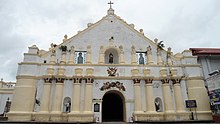Laoag Cathedral
| Laoag Cathedral | |
|---|---|
| Saint William’s Cathedral Catedral de San Guillermo | |
 Façade of Laoag Cathedral in Ilocos Norte | |
 Laoag Cathedral Location in Luzon | |
| 18°11′38″N 120°35′37″E / 18.193811°N 120.593532°ECoordinates: 18°11′38″N 120°35′37″E / 18.193811°N 120.593532°E | |
| Location | Laoag, Ilocos Norte |
| Country | Philippines |
| Denomination | Roman Catholic |
| History | |
| Status | Cathedral |
| Dedication | Saint William of Maleval |
| Architecture | |
| Functional status | Active |
| Architectural type | Church building |
| Style | Italian Renaissance |
| Administration | |
| Archdiocese | Nueva Segovia |
| Metropolis | Laoag |
| Clergy | |
| Archbishop | Marlo Mendoza Peralta |
| Bishop(s) | Renato Mayugba |
Laoag Cathedral, canonically known as Saint William’s Cathedral (Spanish: Catedral de San Guillermo) is a church in Laoag City, Ilocos Norte, Philippines. The current church was built in 1612 by Augustinian friars to replace a wooden chapel. It also serves as the seat or central church of the Roman Catholic Diocese of Laoag.
History[]
The first church of Laoag was made of wood and thatch when the Augustinians established the parish in 1580. The foundations of the current church was laid on 1612. It was damaged by fire in 1843 and was restored from 1873 to 1880 by the Obras Publicas under Engineer Antonio de la Camara and Father Santiago Muniz. The church was occupied by the revolutionists in 1898, and by the American forces in 1899. The ownership of the church was contested by the Aglipayans from the Roman Catholic from which the Catholic church won ownership.[1] The church facade was renovated by adding lime plaster in 1936. It became a cathedral when the Diocese of Laoag was created in 1961. The church was again renovated from 1971 to 1972. It was slightly damaged by an earthquake in 1983.[2]
Features[]

The church is known for its Italian Renaissance design.[3] It also has an unusual two-storey façade, supported by two pairs of columns on each side of the arched entrance. The top of the façade holds a recessed niche that showcases the image of the city's patron saint, San Guillermo el Ermitaño. It has windows made from capiz with wrought iron screens.
It has a main retablo and two smaller ones on its sides. The lower level of the huge retablo contains the image of Saint William, the parish's patron saint.[2]
Sinking Bell Tower[]
The church is also famous for its "Sinking Bell Tower", which sinks into the ground at a rate of an inch a year. It has survived several minor earthquakes since its construction, causing scholars to label it an Earthquake Baroque style structure.[3][4] The tower, built presumably after the 1707 earthquake, has a foundation of 90 metres (300 ft).[3][4] It is made of locally manufactured bricks joined by molasses and juice of sablot leaves[4] mixed with lime and sand, and reinforced with four massive columns on each corner and a winding stairway leading to the belfry. It used to have a large clock on the tower's western face.[5]
Notes[]
- ^ National Historical Institute 1993
- ^ a b Dela Torre 2006, p. 174
- ^ a b c Dela Torre 2006, p. 172
- ^ a b c "The Sinking Bell Tower". Atlas Obscura. Retrieved 26 September 2017.
- ^ Dela Torre 2006, p. 173
Bibliography[]
- Dela Torre, Visitacion (2006). The Ilocos Heritage. Makati: Tower Book House. ISBN 978-971-91030-9-7.
- Historical Markers: Regions I-IV and CAR (in Filipino). Manila: National Historical Institute (Philippines). 1993. p. 88. ISBN 9715380611.
External links[]
![]() Media related to Laoag Cathedral at Wikimedia Commons
Media related to Laoag Cathedral at Wikimedia Commons
- Roman Catholic cathedrals in the Philippines
- Roman Catholic churches in Ilocos Norte
- Buildings and structures in Laoag
- Marked Historical Structures of the Philippines
- Spanish Colonial architecture in the Philippines
- 1612 establishments in New Spain


